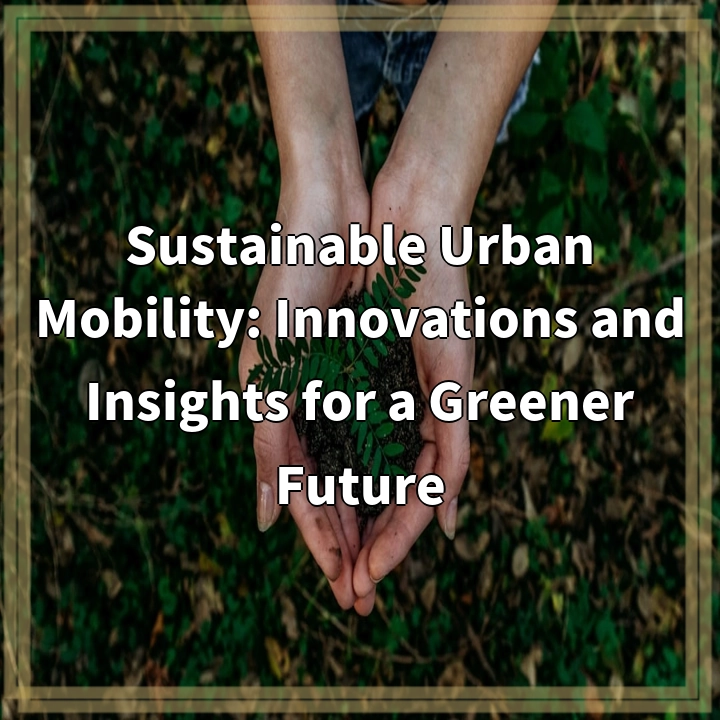
What it is:
Sustainable urban mobility refers to transportation systems and practices that minimize environmental impact while promoting social equity and economic viability. It encompasses various modes of transport, including walking, cycling, public transit, and electric or shared vehicles, all designed to reduce greenhouse gas emissions, ease traffic congestion, and improve accessibility within urban areas. The goal is to create a comprehensive and integrated transportation framework that meets the needs of communities while safeguarding the environment.
Key Principles of Sustainable Urban Mobility
The framework of sustainable urban mobility rests on several key principles. These include enhancing public transport systems, promoting non-motorized transport, encouraging mixed-use development, and implementing smart technology to optimize traffic flow. By prioritizing eco-friendly transportation options, cities aim to decrease reliance on fossil fuels, improve air quality, and foster healthier lifestyles among residents.
Real-world Problems
Urban Sprawl and Traffic Congestion
One of the significant challenges facing sustainable urban mobility is urban sprawl, which often leads to increased reliance on automobiles. This phenomenon results in traffic congestion, longer commute times, and heightened emissions. As cities expand outward, public transport systems often struggle to keep pace, forcing residents into car dependency, exacerbating pollution, and negatively impacting overall quality of life.
Equity and Accessibility Issues
Access to sustainable transport options is not uniformly available across urban populations. Low-income communities often lack adequate public transport links, making it difficult for residents to access jobs, education, and vital services. This inequity can perpetuate a cycle of poverty and social exclusion. Addressing these disparities is essential for promoting sustainable urban mobility that benefits all demographics.
Infrastructure Challenges
Many cities face significant hurdles in developing the necessary infrastructure to support sustainable urban mobility. This includes outdated public transport systems, inadequate cycling paths, and a lack of pedestrian-friendly spaces. Upgrading infrastructure requires substantial investment and planning, which can be a complex process often hindered by political and financial constraints.
Environmental Concerns
Despite the push for sustainability, urban areas continue to face environmental challenges related to transportation. High levels of emissions from vehicles contribute to air pollution, which adversely affects public health and the environment. Furthermore, the construction and maintenance of transport infrastructure can lead to habitat destruction and increased carbon footprints, highlighting the need for environmentally sensitive planning and execution.
Technological Integration
While technology holds the potential to enhance sustainable urban mobility through smart transportation systems and real-time data, it also presents challenges. Issues such as data privacy, cybersecurity, and the digital divide can hinder the effective implementation of innovative solutions. Ensuring that technology is inclusive and beneficial for all users is crucial in advancing sustainable transport initiatives.

Solutions for Sustainable Urban Mobility
Addressing the challenges of sustainable urban mobility requires a multifaceted approach that incorporates policy changes, community engagement, and technological advancements. By implementing strategic solutions, cities can effectively promote a greener and more equitable transportation system.
Enhancing Public Transport Systems
Revamping and expanding public transport networks is crucial for reducing reliance on automobiles. Investments in reliable and efficient bus, tram, and metro services can encourage more residents to utilize public transit, decreasing traffic congestion and emissions. Ensuring that these systems are affordable and accessible will enhance their overall effectiveness.
Promoting Active Transportation
Encouraging walking and cycling can significantly reduce the carbon footprint associated with urban travel. Cities should invest in safe pedestrian pathways and dedicated cycling infrastructure, along with outreach initiatives that promote active transportation as a viable and healthy option for residents.
Implementing Mixed-Use Development
Integrating residential, commercial, and recreational spaces can reduce the need for long commutes and promote the use of alternative transportation modes. Policies that support mixed-use zoning can create more compact and walkable neighborhoods, fostering a sense of community and making sustainable mobility choices more accessible.
Addressing Equity and Accessibility
To ensure that sustainable urban mobility benefits all residents, it is vital to target investments in underserved communities. Tailoring public transport routes and services to meet the needs of low-income individuals will enhance accessibility and reduce social disparities tied to transportation.
Upgrading Infrastructure
Investing in modern infrastructure is essential for supporting sustainable transport systems. Upgrading existing facilities and constructing new ones that prioritize eco-friendly transport options can help cities adapt to the growing demand for sustainable mobility solutions.
Leveraging Technology
Incorporating smart technologies can optimize traffic flow, enhance public transport efficiency, and improve user experiences. Cities should focus on creating inclusive digital platforms that offer real-time information and ensure that all residents can benefit from technological advancements in transportation.















